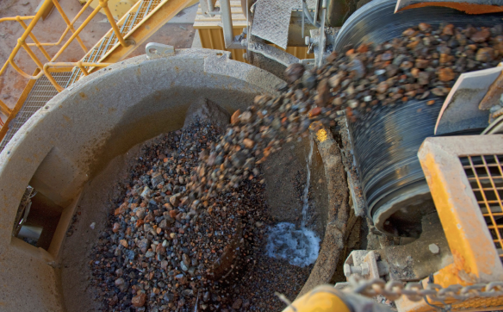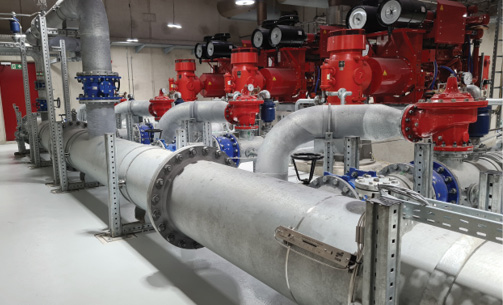Information from intelligent wired and wireless instruments, and other field devices, can help plant personnel optimize operations.
by Sharon McCurdy and Victor Mwaba
The metals and mining industry is a key player in the global energy transition since it provides many of the raw materials needed for critical components, such as batteries, wind turbine blades, and others. These materials must be mined and processed cost-efficiently, while prioritizing safety and sustainability. The key to success in any mining operation depends on operating profitably at current market pricing. Therefore, most mine operators are constantly striving to improve their operational efficiency and reduce production costs, while ensuring that safety and environmental stewardship remain a priority.
Key performance indicators for mining operations center around price per ton of output, tons per day, and capital performance against cost and schedule. Sustainability is now a growing part of that equation, with sites closely monitoring water and energy consumption per ton, along with overall carbon footprint and other emissions.
This column looks at major phases of the mining process, highlighting key measurement technologies that enable mining companies to reduce emissions, water consumption, and energy usage, while improving overall efficiency, sustainability, and safety.


Measure to improve
The first step toward creating a sustainability strategy requires the measurement of critical variables throughout the process. What gets measured, gets improved. Unfortunately, most mine sites are located in remote areas and geographically spread out, making instrumentation difficult to deploy and support due to high installation costs. Industrial wireless technology addresses these issues and allows mines to inexpensively add instruments across sites. Many instruments are available with native wireless communications, and adapters can be added to wired instruments to add wireless capabilities.
Here, we’ll discuss key areas in a typical mining site and list the latest measurement instrumentation available. Many of these instruments are offered in both wired and wireless versions, the latter significantly reducing installation and support costs.
Ore conveying
Belt conveyors offer a versatile and low cost means of moving ore over long distances and changing elevations (see Figure 1). Most conveyors consist of a rubber coated belt riding on V-shaped pairs of rollers to keep the product centered. Rollers can be problematic if they become seized, causing the belt to drag across the surface, creating friction and heat.
In many instances, a seized roller quickly develops sharp edges that can cut the conveyor belt. Failed bearings on pulleys and rollers can also cause conveyor belt fires. Either of these conditions can potentially create extended unplanned downtime; to empty the belt, clean up the spilled material, and perform the necessary repairs.
Maintenance technicians may walk the belt looking for bad rollers, but this type of inspection can be infrequent since many conveyors are quite long, and this task may expose workers to potentially hazardous conditions. A more reliable way to discover hot spots monitors temperature and vibration using wireless technology at each section. The Rosemount 848T Wireless Temperature Transmitter (see Figure 1) can send data from up to four resistance temperature detectors (RTDs) on a single signal. An AMS Wireless Vibration Monitor can sense changes in patterns resulting from rollers that are not turning.
Crushing, grinding and milling
The first size reduction process after the ore has been loaded and hauled from an open pit or underground mine is primary crushing. Ore may be dumped into the primary crusher from trucks, skip cars, and other haulage methods (see Figure 2). Crushers receive ore in its least uniform state, including large and heavy chunks which must be broken up to a more uniform size.
To keep a crusher effective and efficient, it is best to operate within a specific flow window determined by measuring the depth of product in the entry hopper. The inlet chute should also be constantly monitored for blockages.
A non-contacting radar level instrument (see Figure 2) is a good solution for both of these measurements as it can monitor this data in real-time, with no interference from dust and vibration. Using information from this instrument, operators can slow-down and speed-up feed rates as necessary to maintain optimum throughput and reliability.
Grinding/milling equipment tends to be quite large, subjecting the bearings and motors to high stress and vibration. The lubrication oil system makes operation possible, and failure of this system would cause catastrophic damage and months of downtime. Because the lube oil system is so critical, it must be carefully monitored and interlocked to ensure consistent and reliable operation.
Key instruments in this area include the Rosemount 2088 Absolute and Gauge Pressure transmitter; the Rosemount 648 Wireless Temperature Transmitter; the Rosemount 5300 Level Transmitter; the Rosemount 3051SFC Compact Orifice Flow Meter; the Flexim FLUXUS721 Ultrasonic Flow Meter; and the Micro Motion F-Series Coriolis Flow Meter. These instruments work together to confirm oil is available and flowing as it should to maintain production and extend bearing life.
Wireless vibration and temperature sensors can also be used to monitor bearing status and indicate developing problems before catastrophic failure occurs. This enables the site to arrange a planned, proactive repair versus an unplanned, extended outage.


Floatation
After milling ore, added water creates a slurry, which is pumped into a floatation tank. In the tank, fine ore particles attach themselves to compressed air bubbles injected from the flotation tank bottom to create a froth that can be skimmed off the surface (see Figure 3).
Creating the desired bubble size depends on controlling spargers at the bottom of the flotation vessel, where compressed air is pumped into the slurry and released through small orifices. These orifices can clog, so each sparger is typically monitored by a mechanical pressure gauge, which requires a human operator to notice a change indicating clogging. These mechanical gauges can be replaced with Rosemount Wireless Pressure Gauges, which provide the desired local display, and transmit data, enabling the control system to monitor and alarm underperforming spargers.
The slurry flow into flotation vessels must be optimized to maintain maximum recoveries without overwhelming the process, but this slurry flow measurement is difficult due to the variability of percent solids contents in slurry. Specialized meters, such as the Rosemount MS Magnetic sensor and Rosemount 8782 Slurry Transmitter (see Figure 3), are designed to withstand the abrasiveness and address the excessive process noise characteristic of slurries.
Floatation efficiency requires a specific pH level in the solution, so this must be monitored and controlled. The measurement can be challenging due to the high solids content of the process media. The Rosemount 396P pH/ORP sensor is especially recommended for pH control of flotation processes. The reference junction is rugged and highly resistant to coating, resulting in reduced maintenance and process downtime.
Tailings dam controls
The tailings pond is a place to store unusable fines (slimes) and gangue, and it also provides a source of recycled process water, but it can be a potential disaster area affecting safety and the surrounding environment if the dam fails. Key measurements in this area include the percent solids in tailings slurry and the condition of the dike. Also, the water/slurry level is an important measurement to make sure the volume of the slurry does not overfill above the dam.
Additionally, the level of solids beneath the surface must be monitored to ensure even distribution and avoid drawing solids into the return pump (see Figure 4).
When tailings are added to the pond, the moisture content is high, so the solids remain entrained in the fluid. To monitor the potential infiltration of water through the dam, a Rosemount 3051S Wireless Submersible DP Transmitter with a sensor embedded in the tailings embankment can be used to monitor the pore water pressure of the dam.
Non-contacting radar provides pond level measurement, and Rosemount 2120 Vibrating Fork Level switches (see Figure 4) can detect underwater slurries approaching pump inlets. All these instruments help manage risk, enhance safety, and assist in preventing potential dam failures.

Water management
Water consumption at mine sites is under increasing scrutiny as water scarcity problems become more common worldwide. Therefore, all sustainability programs must include water management as a key element. Most mining operations employ some water flow monitoring throughout the facility, but not always with sufficient granularity due to the cost of installing additional flow meters. The Flexim FLUXUS 721 Series clamp-on ultrasonic flow meter (see Figure 5) provides a cost-effective solution, and it can be mounted without pipe penetration or shutdown.
As an alternative, magnetic flow meters equipped with Smart Meter Verification can be used to provide reporting of water usage to federal and state agencies.
Water is needed to perform essential operations such as mineral processing, dust suppression, cooling, and slurry transport. On-site buffer and storage tanks provide water and storage capacity. Without a means of effective measurement and control, continuity of supply may be interrupted, and sites may struggle to comply with environmental regulations. Cost effective and reliable solutions, such as the Rosemount 1208 Level and Flow Transmitter, enable full inventory and process control, ensuring water availability. The transmitter also provides continuous access to detailed data for reporting to authorities, and it reduces or eliminates the need for manual rounds.
When combined as a system with the Rosemount 3490 controller, measured values can be visualized on the display, and up to six pumps may be controlled at chosen levels.
Water conductivity can often indicate the suitability of a water stream for a given application. This measurement provides a wealth of information that can frequently be used to reduce the need for fresh water.
The Rosemount 228 Toroidal Conductivity Sensor, coupled with a Rosemount 1056 Intelligent Four-Wire Transmitter provides spot or continuous readings, each with temperature compensation.
Key takeaways
Wireless instrumentation provides a wide range of opportunities to better control mine processes and improve reliability, productivity, and safety. These instruments can be inexpensively deployed and easily relocated as necessary to improve site operations, operability and profitability. Some key measurements include:
- Ore Conveying. Rosemount 848T Wireless Temperature Transmitters and AMS Wireless Vibration Monitors can monitor rollers and pulley bearing operations to detect developing problems before significant damage occurs.
- Crushing/Grinding/Milling. A Rosemount 5408 Level Transmitter Non-Contacting Radar can maximize throughput of the primary crusher, and Rosemount 848T Wireless Temperature and AMS Wireless Vibration Monitors provide indications of developing rotating equipment problems.
A host of pressure, temp, and flow meters monitor and ensure reliable lubrication system performance. - Floatation. Rosemount Wireless Pressure Gauges enable local and remote monitoring of sparger performance, and Rosemount MS Magnetic sensors and Rosemount 8782 Slurry transmitters provide accurate measurement of slurry flows. Rosemount 396P pH/ORP sensors monitor and maintain tight reagent pH control.
- Tailings Dam. Rosemount 3051S Wireless Submersible DP Transmitters monitor dam integrity, non-contacting radar monitor pond levels, and Rosemount 2120 Vibrating Fork Level switches can be utilized to protect recycle water pumps.
- Water Management. Flexim FLUXUS 721 Series clamp-on ultrasonic flow meters provide flow measurements across the site, and Rosemount 1208 Level and Flow Transmitter and 3490 Controllers can monitor and control remote water tanks. Rosemount 228 Toroidal Conductivity sensors can measure water quality and minimize freshwater usage.
Wireless and instrumentation provides a low cost means for mining facilities to measure valuable data across the site. Such measurements can dramatically improve equipment performance and efficiency, enhance safety, and minimize unplanned outages and lost production. These measurements also enable much improved water utilization by maximizing water recovery and quality.
About the authors: Sharon McCurdy is the global director for Metals & Mining at Emerson. Based in Houston, Sharon has 20 years of experience in measurement and instrumentation across various industries. Victor K. Mwaba is a global industry metals and mining manager with Emerson, where he is a subject matter expert in the mining industry.
